A very small constellation of the northern sky, whose name corresponds to the image of an almost isosceles, acute-angled triangle formed by the three brightest stars of 3rd magnitude. The constellation is located in a nice setting of several striking star clusters. To the northeast lies the "head of Medusa" (β, π, ρ, ω Perseus), to the south is the cluster of stars of the constellation Aries (α, β, γ Arietis), and to the southeast the obsolete, now defunct constellation of the Northern Fly, formed by the stars 33, 35, 39, and 41 Arietis. The Triangle's exhibit is the spiral galaxy M33, the third largest of the Local Group after M31 and our Galaxy. However, because it is large and has a low areal brightness, it is not the best to observe: It is followed by only a handful of colourful binaries and a fair number of faint galaxies, of which, however, only a very small fraction can be detected with an ordinary newton.
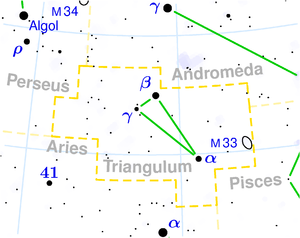
Mettalah (α Trianguli) - Latin "Caput Trianguli" - the apex of the triangle. Its brightness is 3.6 magnitude and it is located 63 light years away. It has two faint companions with magnitudes of 12 and 12.9 at angular distances of 222 "and 83".
6 Tri - Physical binary star, whose companion of 7 mag. can be distinguished from the primary star of 5 mag. using a small telescope.
R Trianguli - The variable star of Mira Ceti type with a magnitude fluctuation from 5.7 to 12.6 with a period of 267 days.
ε Tri - unequal double star with a brighter pale blue component (5.4 magnitude) and a much fainter white companion (11.4 magnitude). They can be easily resolved (3.9 arcseconds) with a 200mm telescope.
ι Tri - A binary star with components of brightness 5.3mag and 6.9mag is separated by 3.9". To resolve the yellow and blue stars, we need an 80mm telescope.
M 33
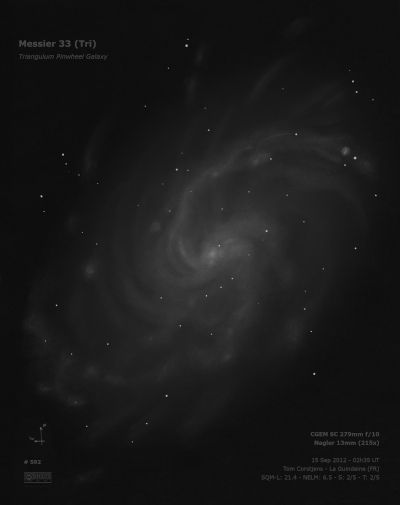
Gioivanni Hodierna probably discovered M33 = NGC 598 = H V-17 = h131 before 1654 and catalogued it as a cloud-like nebulosity or obscuration "near the Triangle". Charles Messier independently discovered M33 on 25 Aug 1764. William Herschel assumed it was new (not found at Messier's position) and catalogued it as H. V-17 on 11 Sep 1784 (sweep 266). On 11 Jan 1787 (sweep 680) he noted "The large nebula. The middle of it easily resolvable and some of the stars visible; it is impossible to say how far it may extend; the nebulosity losing itself so gradually, but goes undoubtedly a great way in every direction, but chiefly from sp to nf." A little later in the sweep he noted "Looked for the 33rd of the Conoiss des Temps, but it is not in the place."
John Herschel included only a single observation in the Slough Catalogue from 15 Sep 1828 (sweep 177): "Enormously L; vgbM. The nucl taken; has a * 12m, nf the nucl. The diffused neb extends 15' s[outh] and as much nearly to n[orth]. It has irregularities of light, and even feeble subordinate nuclei [HII knots] and many small stars."
Lord Rosse or assistant George Johnstone Stoney recognized M33 as a spiral on 6 Sep 1849 and his drawing with four or more spiral arms was included in the 1850 PT paper (plate XXXVI, figure 5). The description reads, "New spiral, s(outh) branch the brightest, none F, nf one short but pB, p(receding) on pretty distinct, sf one but suspected; the whole involved in F neby which probably extends past several knots which lie about it in different directions. Faint nebulosity seems to extend very far following." R.J. Mitchell produced a more detailed drawing on 18 Dec 1857 (included in the 1861 publication). Isaac Roberts produced the first excellent photograph of M33 in 1895 with his 20" reflector, revealing more detail than seen visually.
200/250mm - 8" (10/4/80): the bright central region is slightly grain with the halo showing some indication of spiral arms. The edge of the arms were glimpsed with averted vision.
300/350mm - 13.1" (8/23/84): two prominent spiral arms distinctly visible.
400/500mm - 17.5" (11/1/86): bright, very large, elongated 3:2 SSW-NNE, weakly concentrated irregular halo, rises suddenly to a small bright core. Two prominent spiral arms form an "S-pattern" with an irregular surface brightness. At least a dozen HII regions or clusters are resolved (see the numerous IC listings). Overall, the entire galaxy is very mottled and the outer extent is difficult to define.
Naked-eye - (several times): just glimpsed in very dark skies, perhaps visible 25% of the time in best conditions.
Notes by Steve Gottlieb
NGC 925
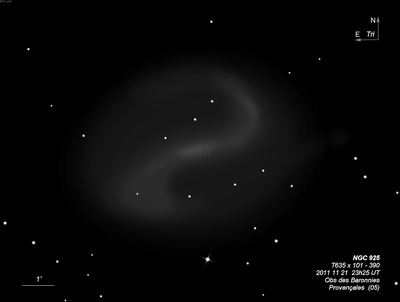
William Herschel discovered NGC 925 = H III-177 = h222 on 13 Sep 1784 (sweep 271) and reported "vF, cL, iR, r, 2 or 3' diameter." On 11 Nov 1827 (sweep 100), John Herschel logged "pB; L; E; vgbM; among stars." Bindon Stoney, using the 72" on 14 Sep 1850, recorded "3' by 50", rather F dash of light; a conspicuous star nf the middle outside edge". The NGC position is accurate.
200/250mm - 8" (11/8/80): faint, fairly large, diffuse, irregular, elongated 2:1 NW-SE, even surface brightness. A mag 10 star is 3.5' S.
400/500mm - 17.5" (11/26/94): fairly bright, large, about 5' diameter although the halo is irregular. The core appears as a bright bar running through the center and elongated WNW-ESE with a fainter halo north and south of the bar. The bar is moderately concentrated and has a mottled texture. There is a strong impression of very faint extensions or arms that begin to hook north on the WNW end and south on the ESE ends of the bar. An extremely faint knot is just visible off the west side 3.3' from the center. This knot is an HII complex and association near the edge of a spiral arm and is catalogued as #120 in Hodge-Kennicutt's 1983 "An Atlas of H II regions in 125 galaxies". Several stars are near; a mag 10.5 star lies 3.4' S of center, two mag 12 stars are just north of the core 1.0' and 1.5' from the center and a wide pair of mag 12.5 star are 5' W. Member of the NGC 1023 Group.
600/800mm - 24" (1/25/14): on this observation I used 375x and focused on the HII regions in the spiral arms of NGC 925. [HK83] 120/121 was seen as an extremely faint, very small HII knot on the west end of NGC 925, 3.2' from center. This HII complex is near the western tip of the southern spiral arm, though I couldn't trace the arm itself as far this knot but a mag 14 star was identified 0.9' SSE.
[HK83] 44, a very faint 6" knot, was barely detached off the east end of the central bar. A second fainter and even smaller knot, [HK83] 46/49, was occasionally seen ~20" WNW, right at the tip of the bar. [HK83] 42, a faint 6" knot, was seen along the weak southern arm, 1.5' SE of center. The location was pinpointed just north of the midpoint of two mag 13.5/14.5 stars oriented E-W at 1.6' separation.
Notes by Steve Gottlieb
UGC 1281
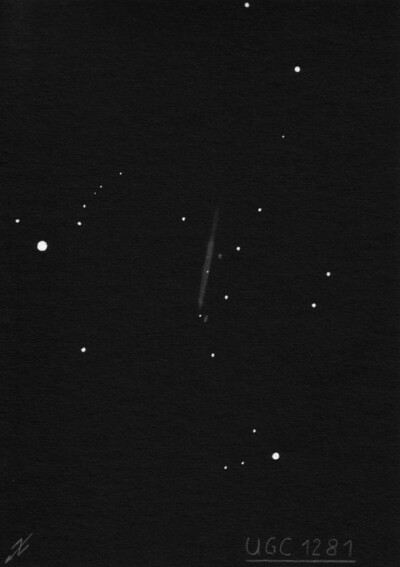
400/500mm - 17.5" (10/5/02): very faint, fairly small, very elongated 7:2 SW-NE, 0.7'x0.2'. Very low surface brightness streak except for a very small brighter core. UGC 1306 lies 16' ESE. Located 12' SE of mag 5.8 SAO 54994. Forms a close pair with CGCG 503-027 (not seen).
17.5" (12/4/93): faint, fairly large, edge-on 5:1 SW-NE, 2.5'x0.5', very low irregular surface brightness. Forms a very close pair with compact CGCG 503-027 close following 0.8' SE of center. Located in a rich star field.
Notes by Steve Gottlieb
NGC 973
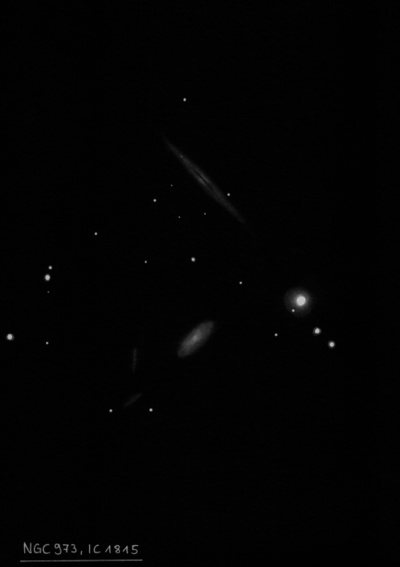
Lewis Swift discovered NGC 973 = Sw. IV-8 on 30 Oct 1885 with the 16" refractor at Warner Observatory and recorded "eeF; S; vE; pB * nr sp". His position and description matches UGC 2048 = PGC 9795.
400/500mm - 17.5" (11/30/91): fairly faint, moderately large, very elongated 3:1 SW-NE. Located 4.5' NE of mag 7.5 SAO 55664. Forms a pair with IC 1815 4.5' S.
Notes by Steve Gottlieb
NGC 672
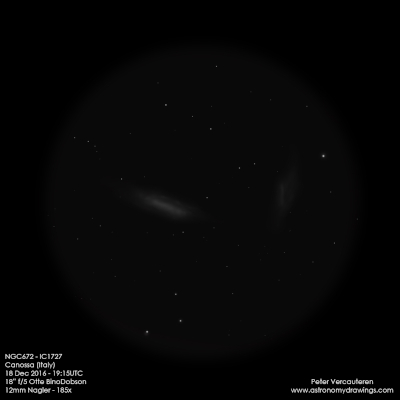
William Herschel discovered NGC 672 = H I-157 = h150 on 26 Oct 1786 (sweep 626) and logged "cB, cL, extended in the parallel, mbM, about 6 or 7' long, 3' broad." The galaxy was observed 7 times with the 72". On 26 Oct 1854, R.J. Mitchell recorded "A tolerably B ray, bM. The B portion is narrow, but I think F neby extends laterally; * south of centre and another fainter one sp center? [this may refer to an HII region]." I'm surprised, though, that IC 1727 was missed during these observations.
200/250mm - 8" (11/13/82): fairly faint, low even surface brightness, fairly large, diffuse. Two mag 13.5 stars lie NW and at the east edge.
8" (11/28/81): faint, fairly large, very diffuse, elongated ~E-W.
300/350mm - 13.1" (11/5/83): fairly bright, elongated 5:2 WSW-ENE, even surface brightness. Bracketed by a mag 13.5 star 2.2' WNW and a mag 13 star 3.2' E. Brightest in a group with IC 1727 8' SW.
600/800mm - 24" (12/28/13): at 225x appeared very bright, very large, elongated 5:2 WSW-ENE, mottled appearance. Contains a brighter, elongated "bar" that is slightly angled (roughly 7:2 E-W) to the major axis of the halo. Slightly brighter "patches" were visible just beyond the bar (on both the east and west side), probably where spiral arms attach to the bar. IC 1727 lies 8' SW.
Notes by Steve Gottlieb
NGC 890
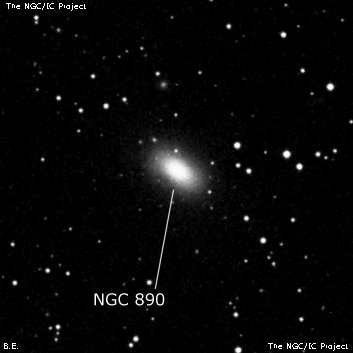
William Herschel discovered NGC 890 = H II-225 = h217 on 13 Sep 1784 (sweep 271) and noted "F, vS, R." John Herschel made 4 observations and first logged it on 11 Nov 1827 (sweep 100) as "pB; R; gbM; has 3 or 4 S st p[receding] in a chain". The galaxy was also observed 6 times at Birr Castle. On 12 Oct 1855, R.J. Mitchell remarked "pL, oval major axis spnf, sbM, probably a distant globular cluster." There are a couple of very faint stars around the periphery and this may have given the impression of a distant globular.
200/250mm - 8" (11/8/80): faint, small, elongated 3:2 SW-NE, wide double star mag 12/13 lies 3' W.
400/500mm - 17.5" (10/29/94): moderately bright, moderately large, elongated 2:1 SW-NE, 2.0'x1.0'. Sharply concentrated with a prominent core containing a stellar nucleus. Using averted vision the faint extensions increase to 2' length. A group of stars is off the west side.
Notes by Steve Gottlieb
NGC 784
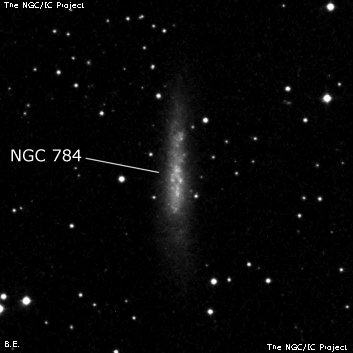
Heinrich d'Arrest discovered NGC 784 on 20 Sep 1865 with the 11-inch refractor at Copenhagen. He questioned if it was elongated or double and his single position is accurate.
400/500mm - 17.5" (11/1/86): fairly bright, very large, very elongated 4:1 N-S, weak concentration.
Notes by Steve Gottlieb
NGC 750
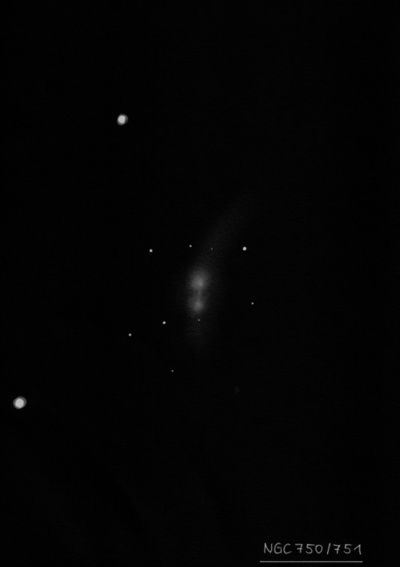
William Herschel discovered NGC 750 = H II-222 = h175 on 12 Sep 1784 (sweep 268) and logged "just like the former." The "former" refers to NGC 736, which was described as "F, pL, mE, r, 1.5' long." This close pair was not resolved by either William or John but first seen at double by Bindon Stoney with the 72" on 11 Oct 1850. John Herschel called the galaxy round on one sweep and elongated on another.
200/250mm - 8" (11/28/81): both components merge into a single object.
300/350mm - 13.1" (10/20/84): double galaxy with NGC 751 N-S, two distinct nuclei in a common halo.
400/500mm - 17.5" (11/1/86): moderately bright, small, round. Forms a contact double system with NGC 751 virtually attached at the south end. Resolved into two distinct galaxies at 220x.
Notes by Steve Gottlieb
NGC 604
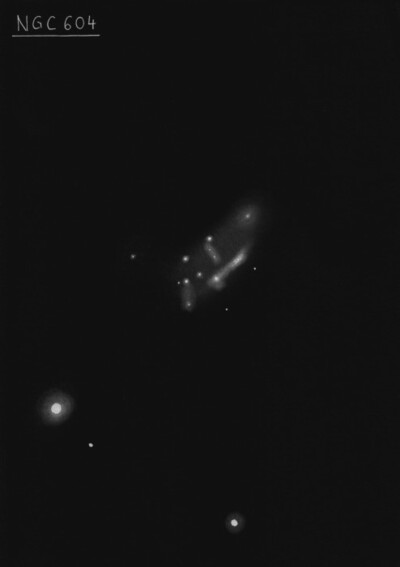
William Herschel discovered NGC 604 = H III-150 = h133 on 11 Sep 1784 (sweep 266) and noted "vF, S, R nebula, brightest in the middle." Lord Rosse or assistant reported on 13 Sep 1850: "large spiral full of knots, north following is a bright, small neb [NGC 604], which on a very good night might appear attached to the spiral, than which it is brighter." Bindon or George Stoney measured an offset from a star superimposed just north of the core of M33 on 2 Jan 1851 and the nebula was labeled as "3" on the diagram in the 1861 publication.
200/250mm - 8" fairly bright, round, knot in M33.
300/350mm - 13.1" (7/5/86): bright HII region located 12' NE of the core of M33. Situated at the end of the large spiral arm of M33 that extends north and then east of the core. Bright, fairly small, ~30" diameter, round.
400/500mm - 18" (12/10/07): bright, large HII knot in M33 at the end of the spiral arm that trails to the east on the north side of the core. A mag 10.5-11 star is located 1.5' SE and NGC 604 is elongated 3:2 in the direction of this star. The outline is oval, though a bit irregular, particularly on the east side. It appears brighter and mottled on the northwest side and with direct vision a slightly brighter stellaring is embedded near the northwest end.
Notes by Steve Gottlieb
NGC 736
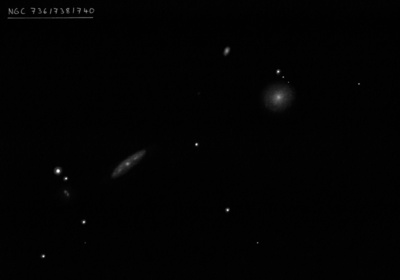
William Herschel discovered NGC 736 = H II-221 = h169 on 12 Sep 1784 (sweep 268) and logged "F, pL, mE, r, 1 1/2' long." JH observed this galaxy on 3 sweeps by and described it on 11 Nov 1827 as "pB; R; bM; has a *13m np". Both Herschel's positions match UGC 1414 = PGC 7289. John Herschel thought his father's description was irreconcileable ("much elongated" vs "R"), so they probably referred to different objects and he assigned separate designations in the General Catalogue. Bindon Stoney sketched the group using the 72" on 11 Oct 1850 and NGC 736 is labeled Alpha.
300/350mm - 13.1" (10/20/84): moderately bright, small, a faint star is at the north edge. A nearly stellar galaxy (NGC 738:) is close NE.
400/500mm - 17.5" (11/1/86): moderately bright, fairly small, round, small bright core, small halo. A mag 15 star is 30" N (this is NGC 737). In a close quadruple group with NGC 738 1.3' NE, NGC 740 3' SE and (R)NGC 733 3.6' WNW.
Notes by Steve Gottlieb
NGC 783
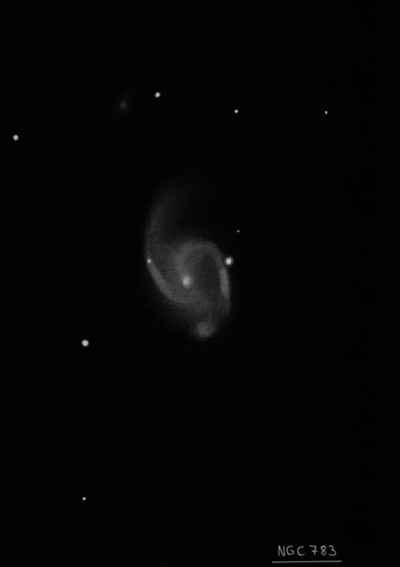
300/350mm - 13.1" (8/24/84): fairly faint, diffuse, slightly elongated E-W, even surface brightness. A mag 13 star is at the WNW edge of halo and a mag 12.5 star is off the SE edge 1.1' from center. Forms a pair with NGC 785 8' ESE.
13.1" (12/22/84): moderately bright.
Notes by Steve Gottlieb
NGC 978
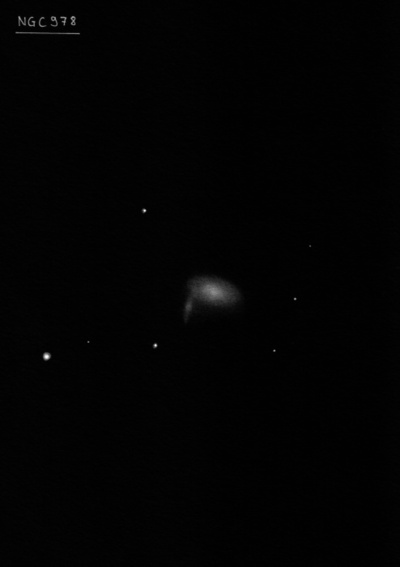
John Herschel discovered NGC 978 = h234, along with NGC 969 and NGC 974, on 22 Nov 1827. His position is a good match with UGC 2057 = PGC 9821, despite being mentioned as roughly placed with respect to NGC 969. The brighter northern component of this double system is identified as NGC 978A in MCG. Forms a contact pair with NGC 978B = MCG +05-07-017 at the southeast end, 0.35' from center.
300/350mm - 13.1" (12/22/84): moderately bright, small, round, small bright core. Brightest of three with NGC 969 10' NW and NGC 974 8' NNW.
400/500mm - 17.5" (12/4/93): moderately bright, fairly small, round, prominent core within a small halo. A mag 11.5 star is 2.3' ESE. Located 6' WSW of mag 7.9 SAO 55679. Brightest of four in a group with NGC 969 10' NW, NGC 974 8' NNW and NGC 970.
600/800mm - 24" (2/18/20): at 375x; moderately bright, fairly small, slightly elongated, ~35"x30", gradually increases to a bright core but no distinct nucleus. NGC 978 is a contact pair with NGC 978B = PGC 9823, which is merged at the SE end of the galaxy. The companion was visible as a very faint, low surface brightness extension, poking out towards the SSE, ~15"x8". It contained a brighter stellar nucleus. Mag 8.1 HD 16015 is 6' ENE and NGC 969, 970 and 974 are ~10' NW.
Notes by Steve Gottlieb
NGC 769
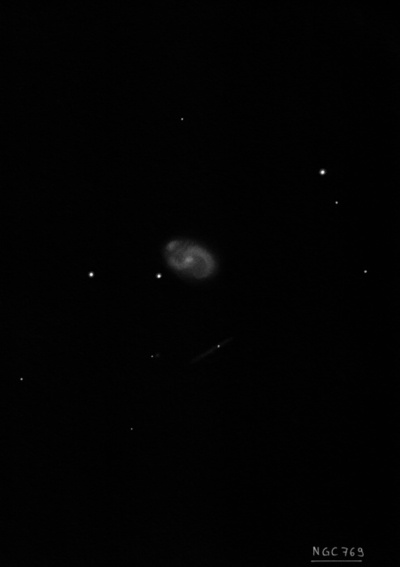
Truman Safford discovered NGC 769 = Sf 68 on 9 Nov 1866 with the 18.5" refractor at the Dearborn Observatory and recorded "S, pF, irr figure, gbM." Édouard Stephan (XII-20) independently found the galaxy on 5 Nov 1882 with the 31" reflector at the Marseille Observatory and Dreyer credits Stephan with the discovery in the NGC as Safford's list was not published until 1887, too late for Dreyer to see while compiling the NGC.
300/350mm - 13.1" (12/22/84): fairly faint, elongated WSW-ENE, fairly even surface brightness. A mag 13 star is on the east edge 30" from the center. Located about 30' SSW of NGC 772.
Notes by Steve Gottlieb
IC 187
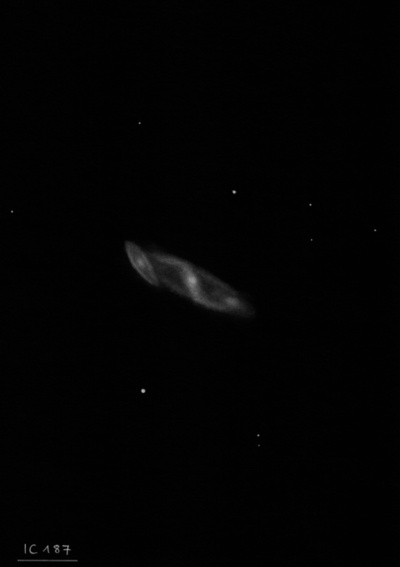
Edward Swift discovered IC 187 = Sw. IX-7, along with IC 188, on 18 Jan 1890 while searching for "Swift's Comet". The RA is 21 sec of time too large, but matches in declination.
400/500mm - 18" (12/22/11): fairly faint, fairly small, elongated 2:1 WSW-ENE, 0.6'x0.3'. Broad concentration with a brighter and rounder 15" core. Forms a double system with PGC 2800932 = MAC 0201+2629. The fainter companion was at or just off the east end and appeared as very faint, small, roundish glow that was sometimes detached, depending on if the halo (arms) of IC 187 was visible or not.
600/800mm - 24" (12/22/14): moderately bright, fairly small, elongated 5:2 WSW-ENE, 0.6'x0.25'. Contains a small, brighter rounder core with fairly low surface brightness extensions that increased in size with averted. Brighter member of an double system with PGC 2800932 at the east-northeast edge. The companion was faint, small and barely detached. An evenly matched 10" pair of mag 12.5-13 stars lies 6' SSW. NED does not include redshift data on the companion, so this may be either be a merging or overlapping pair.
Notes by Steve Gottlieb
NGC 592
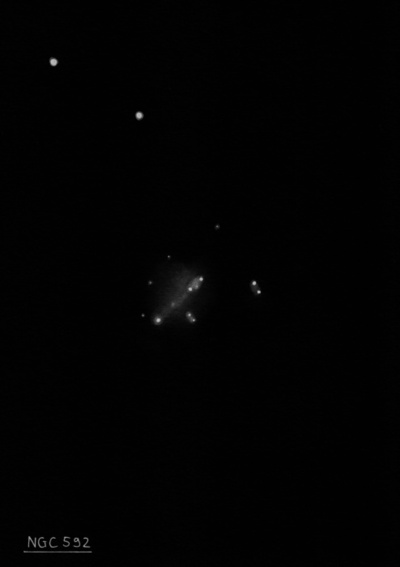
Heinrich d'Arrest discovered NGC 592 = Au 14 in M33, along with NGC 588, on 2 Oct 1861 with the 11-inch Fraunhofer refractor in Copenhagen. His micrometric position (measured on 3 nights) is fairly accurate. Auwers included the discovery in his 1862 catalogue of new nebulae.
In March 2020, Yann Pothier found an earlier discovery by R.J. Mitchell, the observer on Lord Rosse's 72" on 7 Dec 1858. His excellent sketch in the 1862 publication (plate 26, figure 10) includes NGC 592 at the right edge.
300/350mm - 13.1" (8/15/82): fairly easy HII region with averted vision.
400/500mm - 17.5" (7/5/86): faint nebulosity in M33 9' WSW of the core. Forms the vertex of an obtuse isosceles triangle with NGC 588 6' W and NGC 595 6' NE.
Notes by Steve Gottlieb
NGC 588
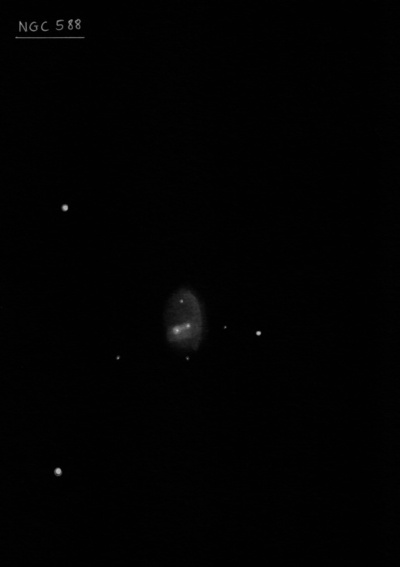
Heinrich d'Arrest discovered NGC 588 = Au 13 in M33, along with NGC 592, on 2 Oct 1861 with the 11-inch Fraunhofer refractor in Copenhagen. His micrometric position (measured on several nights) is accurate. Auwers included this HII region in his 1862 catalogue of 50 new nebulae.
300/350mm - 13.1" (7/5/86): barely visible with averted. Almost collinear with NGC 592 and NGC 595.
400/500mm - 17.5" (7/5/86): extremely faint nebulosity in M33, requires averted vision to view. Located 14' W of the center of M33 and forms the western vertex of a very obtuse isosceles triangle with NGC 592 6' E and NGC 595. Nearly collinear with NGC 592 and the core of M33. This is a HII region and star cluster.
Notes by Steve Gottlieb
NGC 595
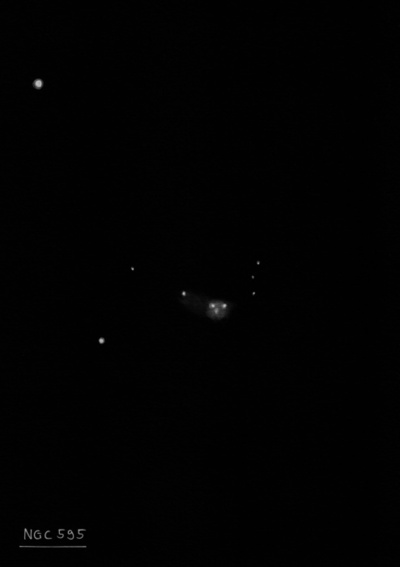
Bindon or George Stoney discovered NGC 595 on 27 Dec 1850 with Lord Rosse's 72" (or perhaps on the 13 Sep 1850 observation, "full of knots") and an offset measured from a star superimposed on M33. The nebula was labeled as "1" on the diagram in the 1861 publication. No coordinates were ever measured at Birr Castle.
Heinrich d'Arrest independently discovered this HII knot on 1 Oct 1864 with the 11-inch refractor at Copenhagen and measured a fairly accurate position (4 seconds of RA too large). d'Arrest is credited with the discovery in the NGC. Truman Safford rediscovered it on 1 Nov 1866 with the 18.5" refractor at the Dearborn Observatory and recorded Sf 63 as "pF, vS, probably a well-known outlier of M33."
300/350mm - 13.1" (8/15/82): visible faintly with averted. Situated at the edge of a spiral arm.
400/500mm - 17.5" (7/5/86): very faint nebulosity in M33, located 4' NW of the center. Situated just off the west edge of the beginning of the spiral arm that extends north and then northeast from the core on the west side. This is a combination star cluster and HII region.
Notes by Steve Gottlieb
UGC 1095
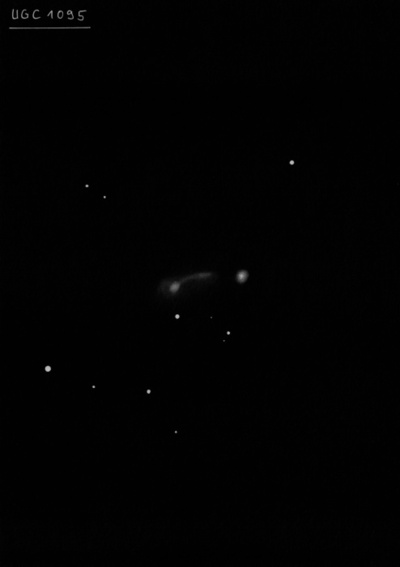
600/800mm - 24" (12/1/13): This is the eastern component of VV 301 = Arp 98, with brighter MCG +05-04-066 1' W. At 260x appeared extremely faint, very small, round, 10" diameter. The core of this interacting spiral was occasionally visible as a very low surface brightness glow, with a mag 13.8 star nearly attached on the south side [20" from center]. The very low surface brightness tidal arms (one extends directly west to MCG +05-04-066) were not visible.
Notes by Steve Gottlieb